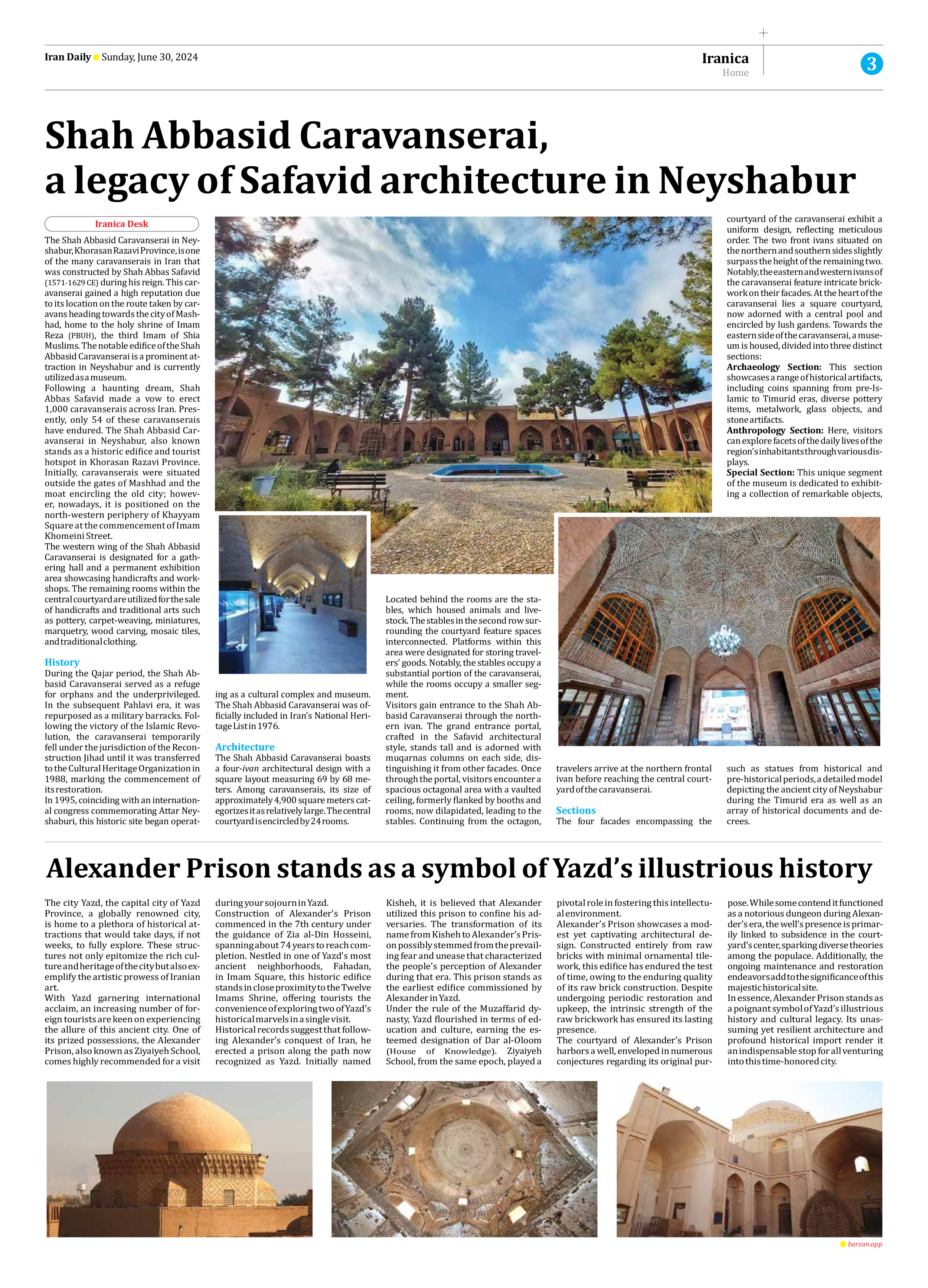
Shah Abbasid Caravanserai, a legacy of Safavid architecture in Neyshabur
The Shah Abbasid Caravanserai in Neyshabur, Khorasan Razavi Province, is one of the many caravanserais in Iran that was constructed by Shah Abbas Safavid (1571-1629 CE) during his reign. This caravanserai gained a high reputation due to its location on the route taken by caravans heading towards the city of Mashhad, home to the holy shrine of Imam Reza (PBUH), the third Imam of Shia Muslims. The notable edifice of the Shah Abbasid Caravanserai is a prominent attraction in Neyshabur and is currently utilized as a museum.
Following a haunting dream, Shah Abbas Safavid made a vow to erect 1,000 caravanserais across Iran. Presently, only 54 of these caravanserais have endured. The Shah Abbasid Caravanserai in Neyshabur, also known stands as a historic edifice and tourist hotspot in Khorasan Razavi Province. Initially, caravanserais were situated outside the gates of Mashhad and the moat encircling the old city; however, nowadays, it is positioned on the north-western periphery of Khayyam Square at the commencement of Imam Khomeini Street.
The western wing of the Shah Abbasid Caravanserai is designated for a gathering hall and a permanent exhibition area showcasing handicrafts and workshops. The remaining rooms within the central courtyard are utilized for the sale of handicrafts and traditional arts such as pottery, carpet-weaving, miniatures, marquetry, wood carving, mosaic tiles, and traditional clothing.
History
During the Qajar period, the Shah Abbasid Caravanserai served as a refuge for orphans and the underprivileged. In the subsequent Pahlavi era, it was repurposed as a military barracks. Following the victory of the Islamic Revolution, the caravanserai temporarily fell under the jurisdiction of the Reconstruction Jihad until it was transferred to the Cultural Heritage Organization in 1988, marking the commencement of its restoration.
In 1995, coinciding with an international congress commemorating Attar Neyshaburi, this historic site began operating as a cultural complex and museum. The Shah Abbasid Caravanserai was officially included in Iran’s National Heritage List in 1976.
Architecture
The Shah Abbasid Caravanserai boasts a four-ivan architectural design with a square layout measuring 69 by 68 meters. Among caravanserais, its size of approximately 4,900 square meters categorizes it as relatively large. The central courtyard is encircled by 24 rooms.
Located behind the rooms are the stables, which housed animals and livestock. The stables in the second row surrounding the courtyard feature spaces interconnected. Platforms within this area were designated for storing travelers’ goods. Notably, the stables occupy a substantial portion of the caravanserai, while the rooms occupy a smaller segment.
Visitors gain entrance to the Shah Abbasid Caravanserai through the northern ivan. The grand entrance portal, crafted in the Safavid architectural style, stands tall and is adorned with muqarnas columns on each side, distinguishing it from other facades. Once through the portal, visitors encounter a spacious octagonal area with a vaulted ceiling, formerly flanked by booths and rooms, now dilapidated, leading to the stables. Continuing from the octagon, travelers arrive at the northern frontal ivan before reaching the central courtyard of the caravanserai.
Sections
The four facades encompassing the courtyard of the caravanserai exhibit a uniform design, reflecting meticulous order. The two front ivans situated on the northern and southern sides slightly surpass the height of the remaining two. Notably, the eastern and western ivans of the caravanserai feature intricate brickwork on their facades. At the heart of the caravanserai lies a square courtyard, now adorned with a central pool and encircled by lush gardens. Towards the eastern side of the caravanserai, a museum is housed, divided into three distinct sections:
Archaeology Section: This section showcases a range of historical artifacts, including coins spanning from pre-Islamic to Timurid eras, diverse pottery items, metalwork, glass objects, and stone artifacts.
Anthropology Section: Here, visitors can explore facets of the daily lives of the region’s inhabitants through various displays.
Special Section: This unique segment of the museum is dedicated to exhibiting a collection of remarkable objects, such as statues from historical and pre-historical periods, a detailed model depicting the ancient city of Neyshabur during the Timurid era as well as an array of historical documents and decrees.







